Developing Individuals, Teams and Organisations : Skills & Knowledge
VerifiedAdded on 2021/02/18
|18
|4405
|17
AI Summary
Contribute Materials
Your contribution can guide someone’s learning journey. Share your
documents today.
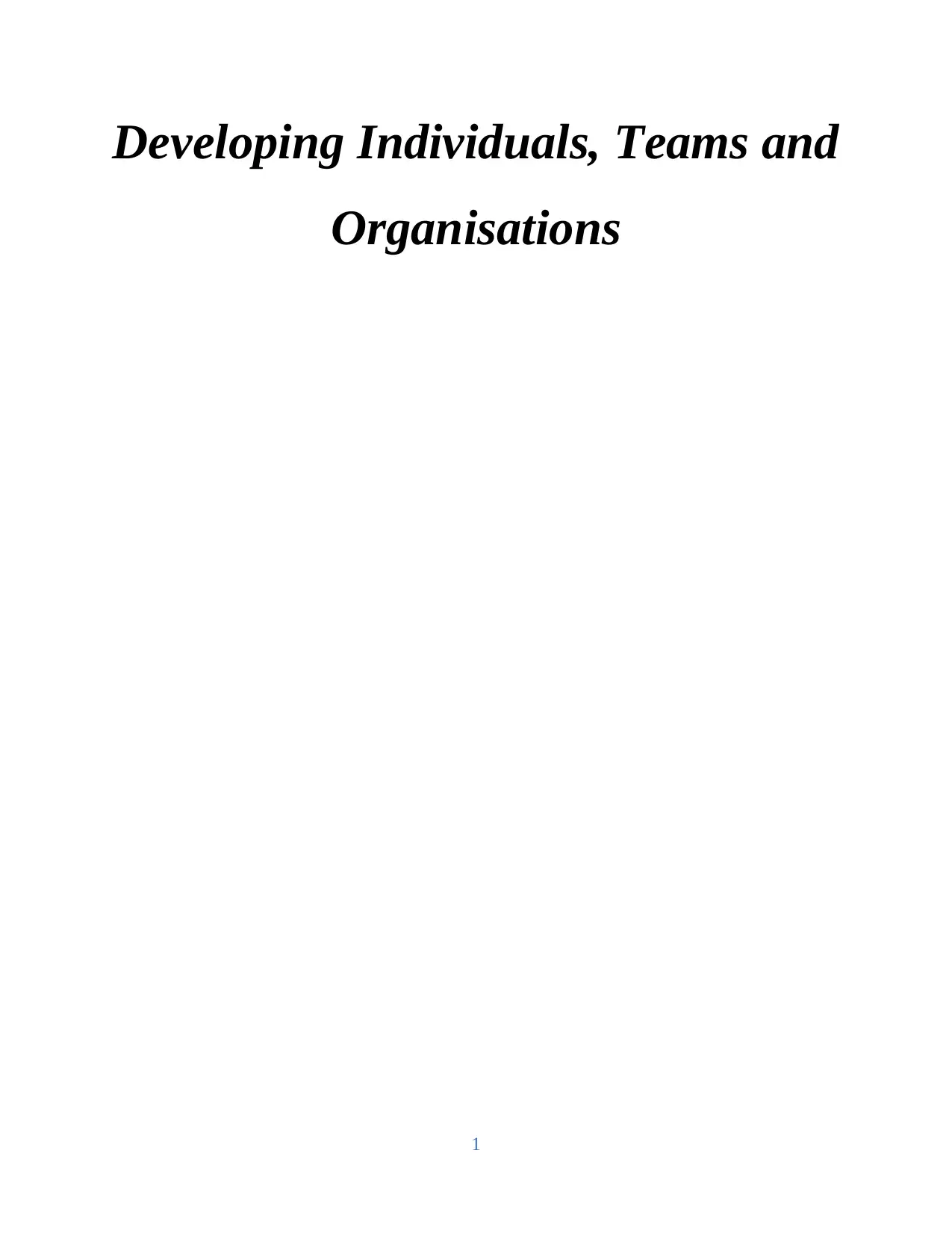
Developing Individuals, Teams and
Organisations
1
Organisations
1
Secure Best Marks with AI Grader
Need help grading? Try our AI Grader for instant feedback on your assignments.
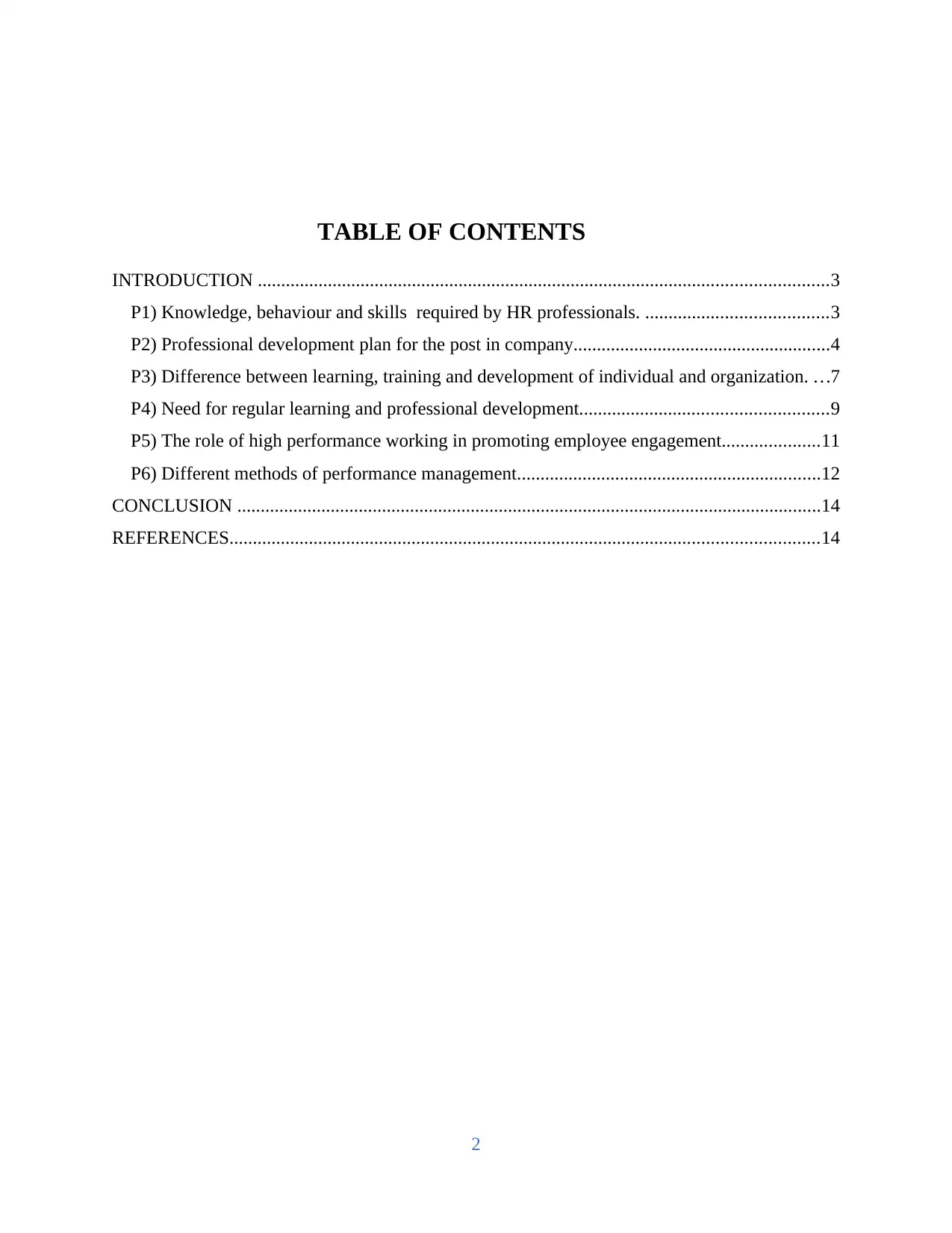
TABLE OF CONTENTS
INTRODUCTION ..........................................................................................................................3
P1) Knowledge, behaviour and skills required by HR professionals. .......................................3
P2) Professional development plan for the post in company.......................................................4
P3) Difference between learning, training and development of individual and organization. ...7
P4) Need for regular learning and professional development.....................................................9
P5) The role of high performance working in promoting employee engagement.....................11
P6) Different methods of performance management.................................................................12
CONCLUSION .............................................................................................................................14
REFERENCES..............................................................................................................................14
2
INTRODUCTION ..........................................................................................................................3
P1) Knowledge, behaviour and skills required by HR professionals. .......................................3
P2) Professional development plan for the post in company.......................................................4
P3) Difference between learning, training and development of individual and organization. ...7
P4) Need for regular learning and professional development.....................................................9
P5) The role of high performance working in promoting employee engagement.....................11
P6) Different methods of performance management.................................................................12
CONCLUSION .............................................................................................................................14
REFERENCES..............................................................................................................................14
2
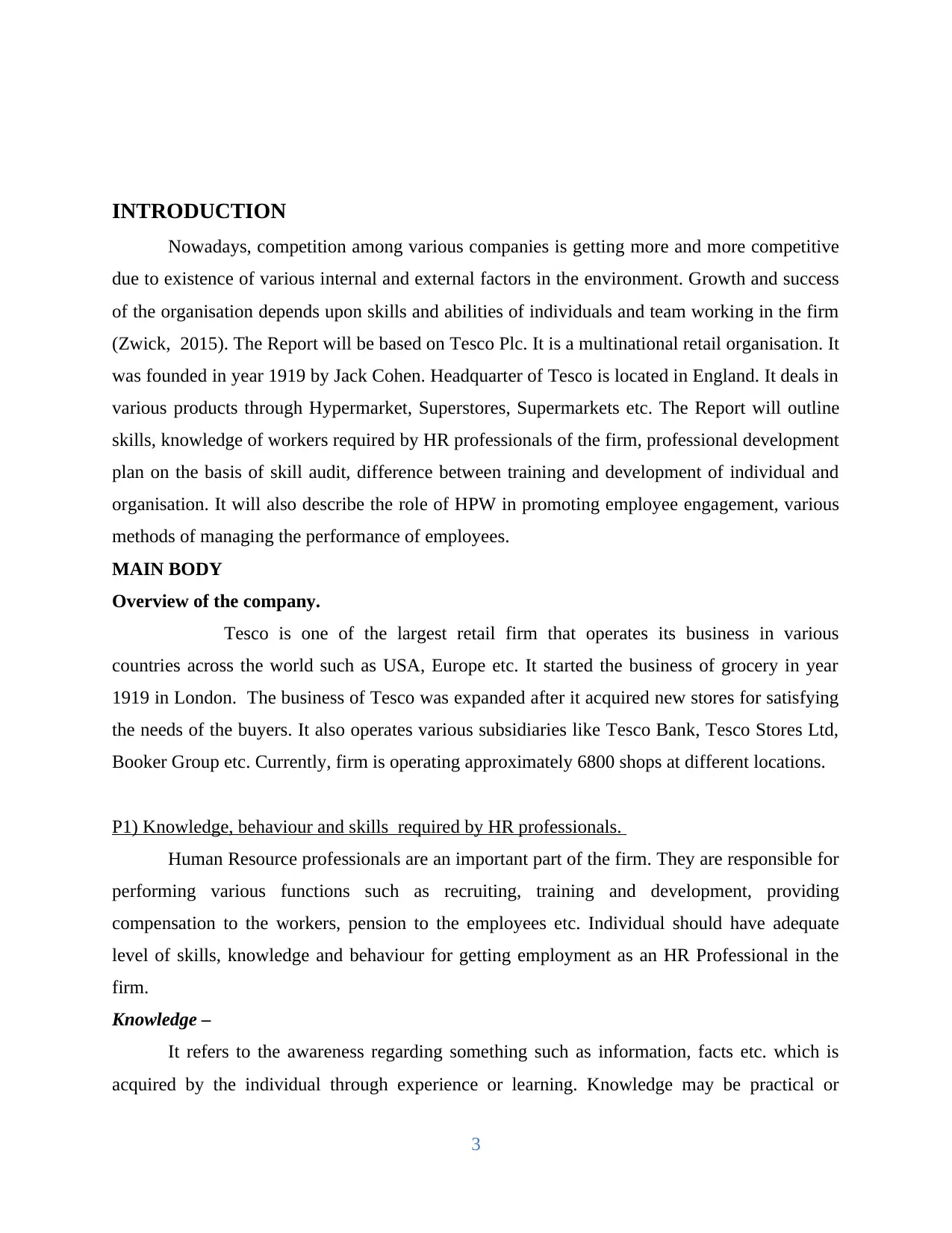
INTRODUCTION
Nowadays, competition among various companies is getting more and more competitive
due to existence of various internal and external factors in the environment. Growth and success
of the organisation depends upon skills and abilities of individuals and team working in the firm
(Zwick, 2015). The Report will be based on Tesco Plc. It is a multinational retail organisation. It
was founded in year 1919 by Jack Cohen. Headquarter of Tesco is located in England. It deals in
various products through Hypermarket, Superstores, Supermarkets etc. The Report will outline
skills, knowledge of workers required by HR professionals of the firm, professional development
plan on the basis of skill audit, difference between training and development of individual and
organisation. It will also describe the role of HPW in promoting employee engagement, various
methods of managing the performance of employees.
MAIN BODY
Overview of the company.
Tesco is one of the largest retail firm that operates its business in various
countries across the world such as USA, Europe etc. It started the business of grocery in year
1919 in London. The business of Tesco was expanded after it acquired new stores for satisfying
the needs of the buyers. It also operates various subsidiaries like Tesco Bank, Tesco Stores Ltd,
Booker Group etc. Currently, firm is operating approximately 6800 shops at different locations.
P1) Knowledge, behaviour and skills required by HR professionals.
Human Resource professionals are an important part of the firm. They are responsible for
performing various functions such as recruiting, training and development, providing
compensation to the workers, pension to the employees etc. Individual should have adequate
level of skills, knowledge and behaviour for getting employment as an HR Professional in the
firm.
Knowledge –
It refers to the awareness regarding something such as information, facts etc. which is
acquired by the individual through experience or learning. Knowledge may be practical or
3
Nowadays, competition among various companies is getting more and more competitive
due to existence of various internal and external factors in the environment. Growth and success
of the organisation depends upon skills and abilities of individuals and team working in the firm
(Zwick, 2015). The Report will be based on Tesco Plc. It is a multinational retail organisation. It
was founded in year 1919 by Jack Cohen. Headquarter of Tesco is located in England. It deals in
various products through Hypermarket, Superstores, Supermarkets etc. The Report will outline
skills, knowledge of workers required by HR professionals of the firm, professional development
plan on the basis of skill audit, difference between training and development of individual and
organisation. It will also describe the role of HPW in promoting employee engagement, various
methods of managing the performance of employees.
MAIN BODY
Overview of the company.
Tesco is one of the largest retail firm that operates its business in various
countries across the world such as USA, Europe etc. It started the business of grocery in year
1919 in London. The business of Tesco was expanded after it acquired new stores for satisfying
the needs of the buyers. It also operates various subsidiaries like Tesco Bank, Tesco Stores Ltd,
Booker Group etc. Currently, firm is operating approximately 6800 shops at different locations.
P1) Knowledge, behaviour and skills required by HR professionals.
Human Resource professionals are an important part of the firm. They are responsible for
performing various functions such as recruiting, training and development, providing
compensation to the workers, pension to the employees etc. Individual should have adequate
level of skills, knowledge and behaviour for getting employment as an HR Professional in the
firm.
Knowledge –
It refers to the awareness regarding something such as information, facts etc. which is
acquired by the individual through experience or learning. Knowledge may be practical or
3
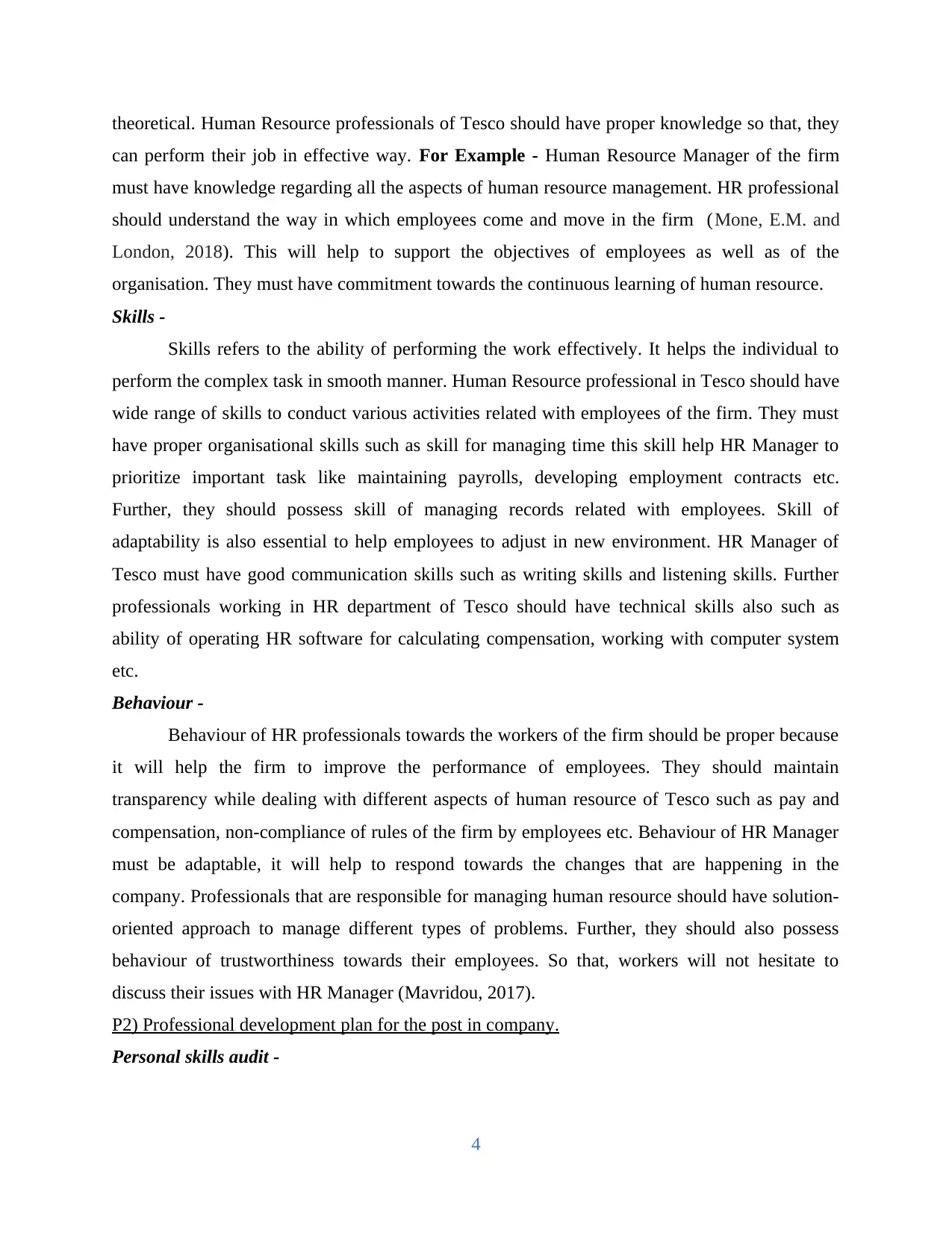
theoretical. Human Resource professionals of Tesco should have proper knowledge so that, they
can perform their job in effective way. For Example - Human Resource Manager of the firm
must have knowledge regarding all the aspects of human resource management. HR professional
should understand the way in which employees come and move in the firm (Mone, E.M. and
London, 2018). This will help to support the objectives of employees as well as of the
organisation. They must have commitment towards the continuous learning of human resource.
Skills -
Skills refers to the ability of performing the work effectively. It helps the individual to
perform the complex task in smooth manner. Human Resource professional in Tesco should have
wide range of skills to conduct various activities related with employees of the firm. They must
have proper organisational skills such as skill for managing time this skill help HR Manager to
prioritize important task like maintaining payrolls, developing employment contracts etc.
Further, they should possess skill of managing records related with employees. Skill of
adaptability is also essential to help employees to adjust in new environment. HR Manager of
Tesco must have good communication skills such as writing skills and listening skills. Further
professionals working in HR department of Tesco should have technical skills also such as
ability of operating HR software for calculating compensation, working with computer system
etc.
Behaviour -
Behaviour of HR professionals towards the workers of the firm should be proper because
it will help the firm to improve the performance of employees. They should maintain
transparency while dealing with different aspects of human resource of Tesco such as pay and
compensation, non-compliance of rules of the firm by employees etc. Behaviour of HR Manager
must be adaptable, it will help to respond towards the changes that are happening in the
company. Professionals that are responsible for managing human resource should have solution-
oriented approach to manage different types of problems. Further, they should also possess
behaviour of trustworthiness towards their employees. So that, workers will not hesitate to
discuss their issues with HR Manager (Mavridou, 2017).
P2) Professional development plan for the post in company.
Personal skills audit -
4
can perform their job in effective way. For Example - Human Resource Manager of the firm
must have knowledge regarding all the aspects of human resource management. HR professional
should understand the way in which employees come and move in the firm (Mone, E.M. and
London, 2018). This will help to support the objectives of employees as well as of the
organisation. They must have commitment towards the continuous learning of human resource.
Skills -
Skills refers to the ability of performing the work effectively. It helps the individual to
perform the complex task in smooth manner. Human Resource professional in Tesco should have
wide range of skills to conduct various activities related with employees of the firm. They must
have proper organisational skills such as skill for managing time this skill help HR Manager to
prioritize important task like maintaining payrolls, developing employment contracts etc.
Further, they should possess skill of managing records related with employees. Skill of
adaptability is also essential to help employees to adjust in new environment. HR Manager of
Tesco must have good communication skills such as writing skills and listening skills. Further
professionals working in HR department of Tesco should have technical skills also such as
ability of operating HR software for calculating compensation, working with computer system
etc.
Behaviour -
Behaviour of HR professionals towards the workers of the firm should be proper because
it will help the firm to improve the performance of employees. They should maintain
transparency while dealing with different aspects of human resource of Tesco such as pay and
compensation, non-compliance of rules of the firm by employees etc. Behaviour of HR Manager
must be adaptable, it will help to respond towards the changes that are happening in the
company. Professionals that are responsible for managing human resource should have solution-
oriented approach to manage different types of problems. Further, they should also possess
behaviour of trustworthiness towards their employees. So that, workers will not hesitate to
discuss their issues with HR Manager (Mavridou, 2017).
P2) Professional development plan for the post in company.
Personal skills audit -
4
Secure Best Marks with AI Grader
Need help grading? Try our AI Grader for instant feedback on your assignments.
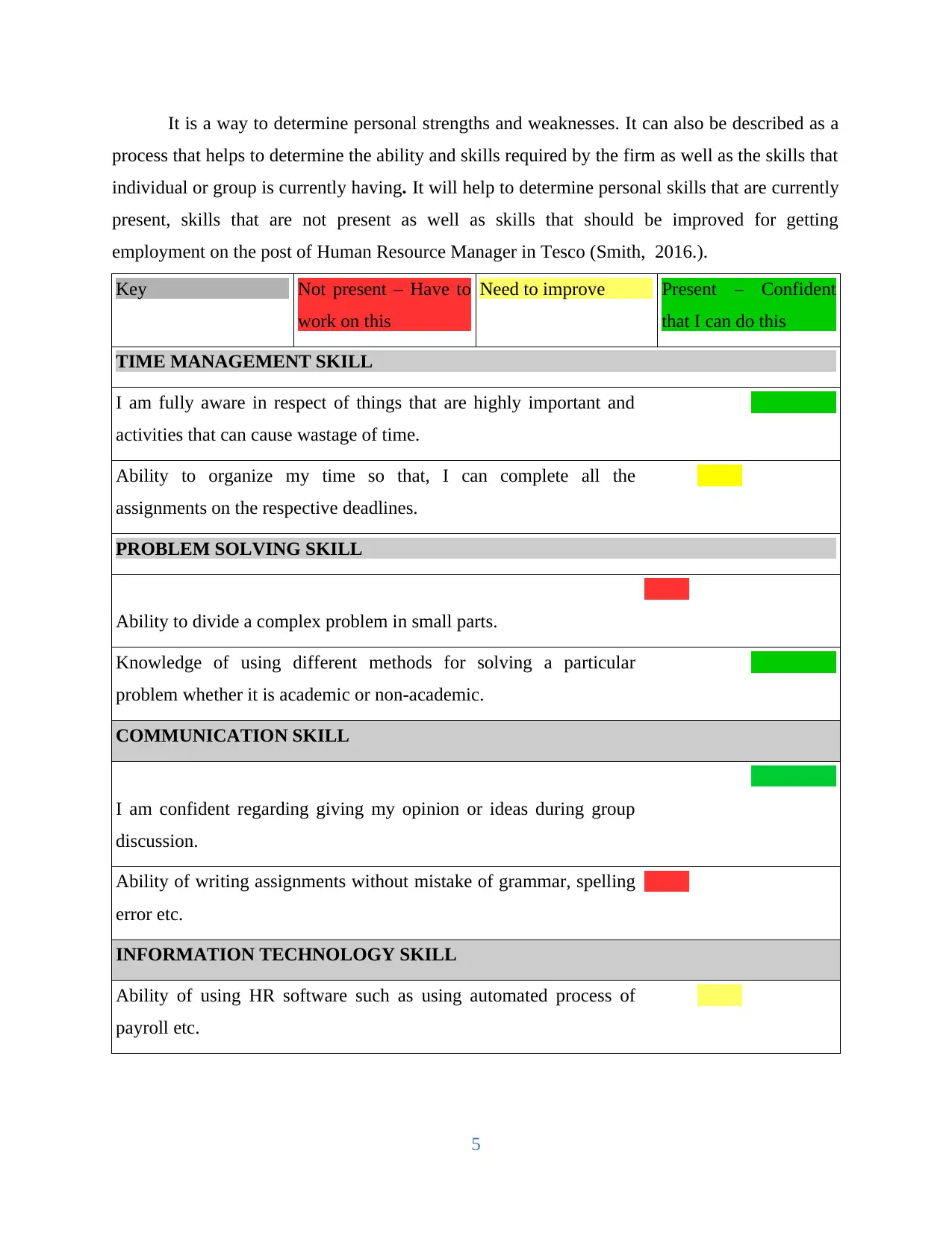
It is a way to determine personal strengths and weaknesses. It can also be described as a
process that helps to determine the ability and skills required by the firm as well as the skills that
individual or group is currently having. It will help to determine personal skills that are currently
present, skills that are not present as well as skills that should be improved for getting
employment on the post of Human Resource Manager in Tesco (Smith, 2016.).
Key Not present – Have to
work on this
Need to improve Present – Confident
that I can do this
TIME MANAGEMENT SKILL
I am fully aware in respect of things that are highly important and
activities that can cause wastage of time.
Ability to organize my time so that, I can complete all the
assignments on the respective deadlines.
PROBLEM SOLVING SKILL
Ability to divide a complex problem in small parts.
Knowledge of using different methods for solving a particular
problem whether it is academic or non-academic.
COMMUNICATION SKILL
I am confident regarding giving my opinion or ideas during group
discussion.
Ability of writing assignments without mistake of grammar, spelling
error etc.
INFORMATION TECHNOLOGY SKILL
Ability of using HR software such as using automated process of
payroll etc.
5
process that helps to determine the ability and skills required by the firm as well as the skills that
individual or group is currently having. It will help to determine personal skills that are currently
present, skills that are not present as well as skills that should be improved for getting
employment on the post of Human Resource Manager in Tesco (Smith, 2016.).
Key Not present – Have to
work on this
Need to improve Present – Confident
that I can do this
TIME MANAGEMENT SKILL
I am fully aware in respect of things that are highly important and
activities that can cause wastage of time.
Ability to organize my time so that, I can complete all the
assignments on the respective deadlines.
PROBLEM SOLVING SKILL
Ability to divide a complex problem in small parts.
Knowledge of using different methods for solving a particular
problem whether it is academic or non-academic.
COMMUNICATION SKILL
I am confident regarding giving my opinion or ideas during group
discussion.
Ability of writing assignments without mistake of grammar, spelling
error etc.
INFORMATION TECHNOLOGY SKILL
Ability of using HR software such as using automated process of
payroll etc.
5
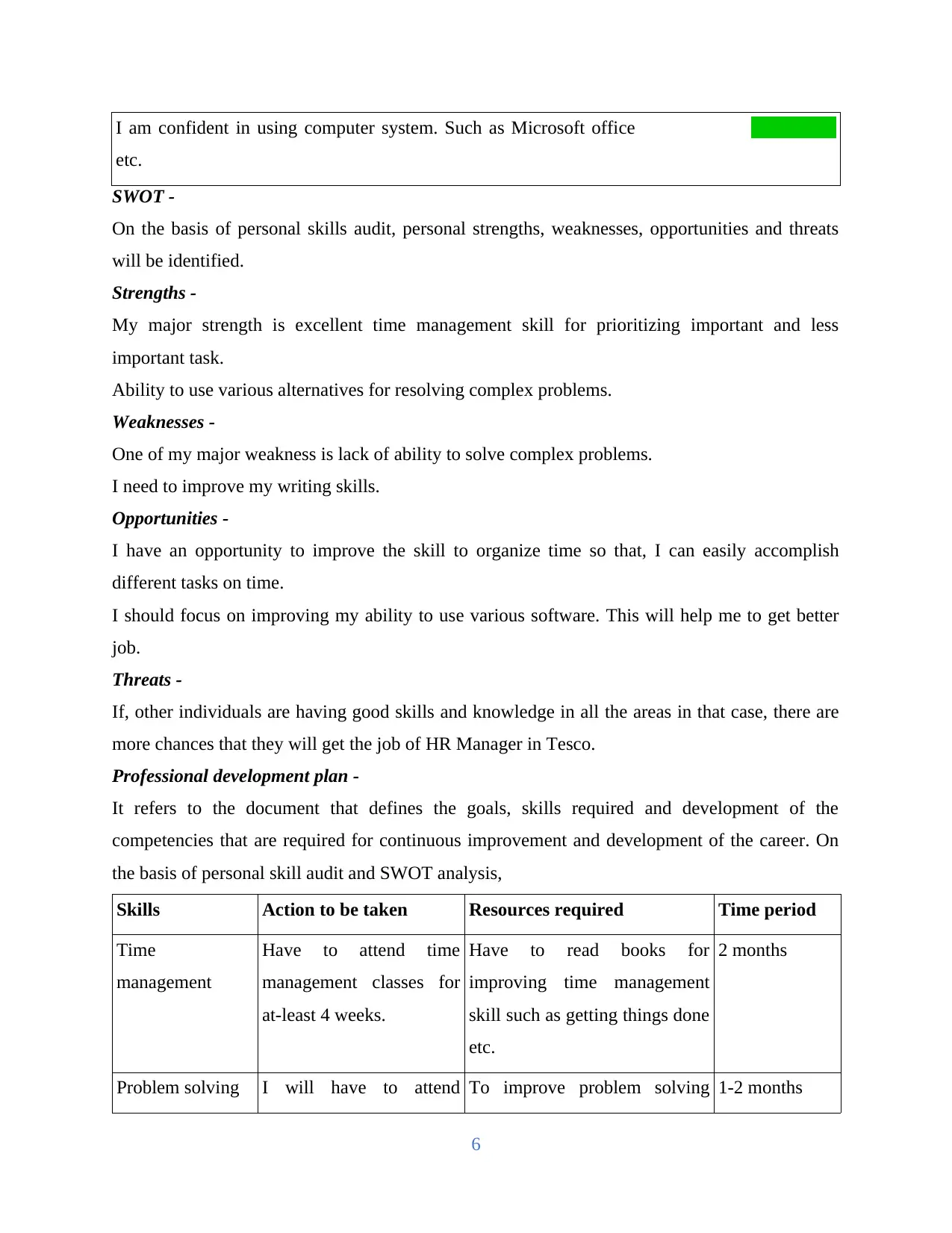
I am confident in using computer system. Such as Microsoft office
etc.
SWOT -
On the basis of personal skills audit, personal strengths, weaknesses, opportunities and threats
will be identified.
Strengths -
My major strength is excellent time management skill for prioritizing important and less
important task.
Ability to use various alternatives for resolving complex problems.
Weaknesses -
One of my major weakness is lack of ability to solve complex problems.
I need to improve my writing skills.
Opportunities -
I have an opportunity to improve the skill to organize time so that, I can easily accomplish
different tasks on time.
I should focus on improving my ability to use various software. This will help me to get better
job.
Threats -
If, other individuals are having good skills and knowledge in all the areas in that case, there are
more chances that they will get the job of HR Manager in Tesco.
Professional development plan -
It refers to the document that defines the goals, skills required and development of the
competencies that are required for continuous improvement and development of the career. On
the basis of personal skill audit and SWOT analysis,
Skills Action to be taken Resources required Time period
Time
management
Have to attend time
management classes for
at-least 4 weeks.
Have to read books for
improving time management
skill such as getting things done
etc.
2 months
Problem solving I will have to attend To improve problem solving 1-2 months
6
etc.
SWOT -
On the basis of personal skills audit, personal strengths, weaknesses, opportunities and threats
will be identified.
Strengths -
My major strength is excellent time management skill for prioritizing important and less
important task.
Ability to use various alternatives for resolving complex problems.
Weaknesses -
One of my major weakness is lack of ability to solve complex problems.
I need to improve my writing skills.
Opportunities -
I have an opportunity to improve the skill to organize time so that, I can easily accomplish
different tasks on time.
I should focus on improving my ability to use various software. This will help me to get better
job.
Threats -
If, other individuals are having good skills and knowledge in all the areas in that case, there are
more chances that they will get the job of HR Manager in Tesco.
Professional development plan -
It refers to the document that defines the goals, skills required and development of the
competencies that are required for continuous improvement and development of the career. On
the basis of personal skill audit and SWOT analysis,
Skills Action to be taken Resources required Time period
Time
management
Have to attend time
management classes for
at-least 4 weeks.
Have to read books for
improving time management
skill such as getting things done
etc.
2 months
Problem solving I will have to attend To improve problem solving 1-2 months
6
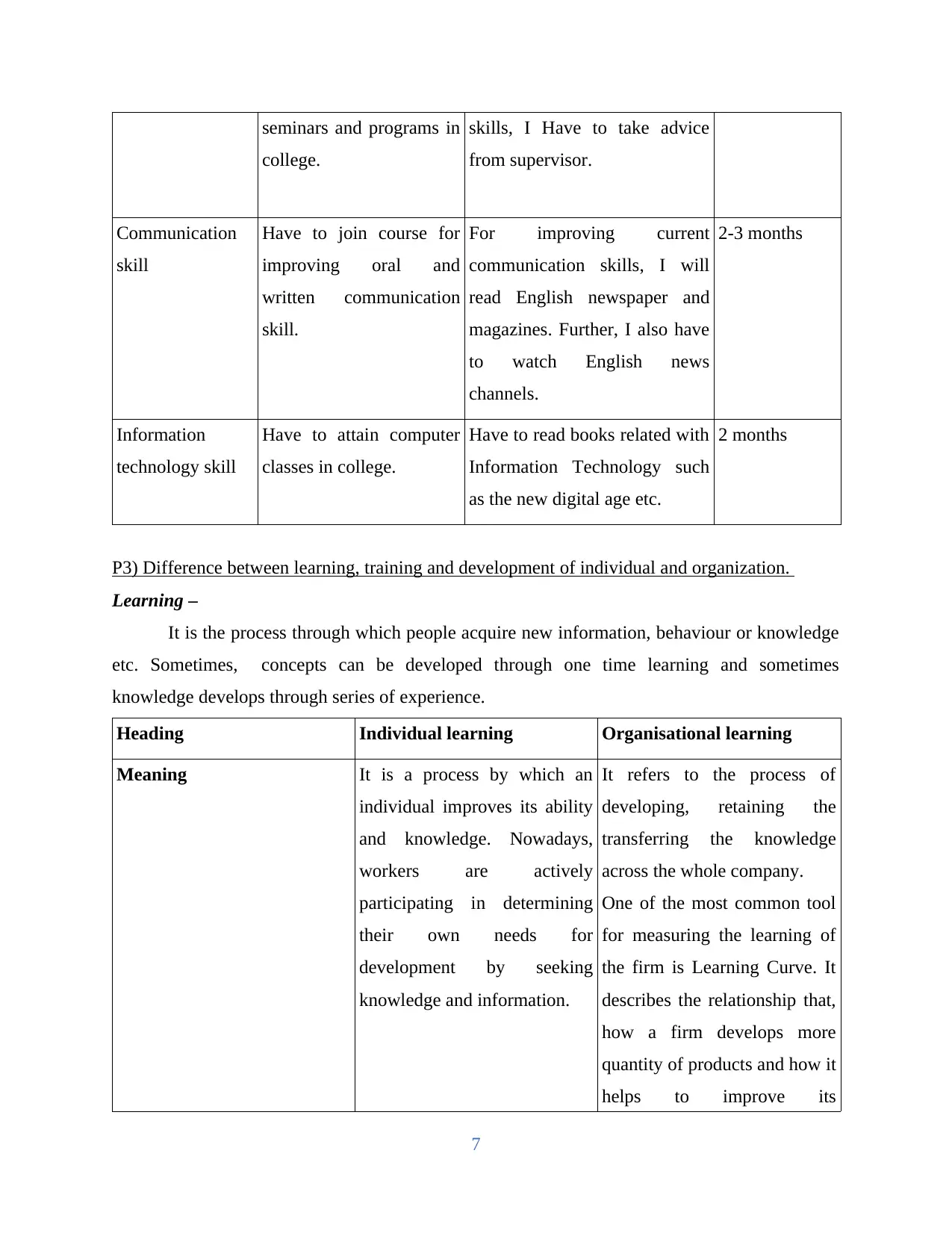
seminars and programs in
college.
skills, I Have to take advice
from supervisor.
Communication
skill
Have to join course for
improving oral and
written communication
skill.
For improving current
communication skills, I will
read English newspaper and
magazines. Further, I also have
to watch English news
channels.
2-3 months
Information
technology skill
Have to attain computer
classes in college.
Have to read books related with
Information Technology such
as the new digital age etc.
2 months
P3) Difference between learning, training and development of individual and organization.
Learning –
It is the process through which people acquire new information, behaviour or knowledge
etc. Sometimes, concepts can be developed through one time learning and sometimes
knowledge develops through series of experience.
Heading Individual learning Organisational learning
Meaning It is a process by which an
individual improves its ability
and knowledge. Nowadays,
workers are actively
participating in determining
their own needs for
development by seeking
knowledge and information.
It refers to the process of
developing, retaining the
transferring the knowledge
across the whole company.
One of the most common tool
for measuring the learning of
the firm is Learning Curve. It
describes the relationship that,
how a firm develops more
quantity of products and how it
helps to improve its
7
college.
skills, I Have to take advice
from supervisor.
Communication
skill
Have to join course for
improving oral and
written communication
skill.
For improving current
communication skills, I will
read English newspaper and
magazines. Further, I also have
to watch English news
channels.
2-3 months
Information
technology skill
Have to attain computer
classes in college.
Have to read books related with
Information Technology such
as the new digital age etc.
2 months
P3) Difference between learning, training and development of individual and organization.
Learning –
It is the process through which people acquire new information, behaviour or knowledge
etc. Sometimes, concepts can be developed through one time learning and sometimes
knowledge develops through series of experience.
Heading Individual learning Organisational learning
Meaning It is a process by which an
individual improves its ability
and knowledge. Nowadays,
workers are actively
participating in determining
their own needs for
development by seeking
knowledge and information.
It refers to the process of
developing, retaining the
transferring the knowledge
across the whole company.
One of the most common tool
for measuring the learning of
the firm is Learning Curve. It
describes the relationship that,
how a firm develops more
quantity of products and how it
helps to improve its
7
Paraphrase This Document
Need a fresh take? Get an instant paraphrase of this document with our AI Paraphraser
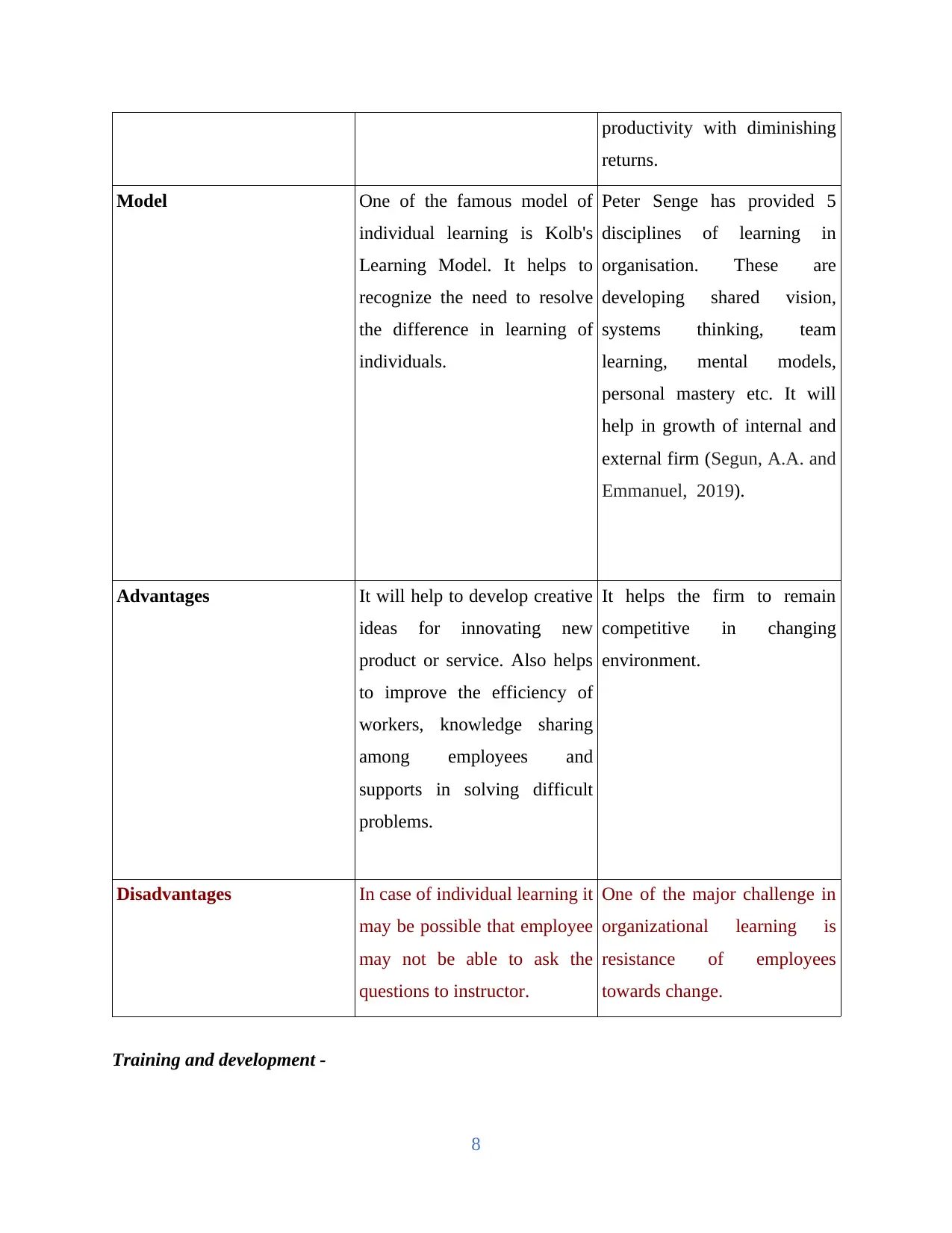
productivity with diminishing
returns.
Model One of the famous model of
individual learning is Kolb's
Learning Model. It helps to
recognize the need to resolve
the difference in learning of
individuals.
Peter Senge has provided 5
disciplines of learning in
organisation. These are
developing shared vision,
systems thinking, team
learning, mental models,
personal mastery etc. It will
help in growth of internal and
external firm (Segun, A.A. and
Emmanuel, 2019).
Advantages It will help to develop creative
ideas for innovating new
product or service. Also helps
to improve the efficiency of
workers, knowledge sharing
among employees and
supports in solving difficult
problems.
It helps the firm to remain
competitive in changing
environment.
Disadvantages In case of individual learning it
may be possible that employee
may not be able to ask the
questions to instructor.
One of the major challenge in
organizational learning is
resistance of employees
towards change.
Training and development -
8
returns.
Model One of the famous model of
individual learning is Kolb's
Learning Model. It helps to
recognize the need to resolve
the difference in learning of
individuals.
Peter Senge has provided 5
disciplines of learning in
organisation. These are
developing shared vision,
systems thinking, team
learning, mental models,
personal mastery etc. It will
help in growth of internal and
external firm (Segun, A.A. and
Emmanuel, 2019).
Advantages It will help to develop creative
ideas for innovating new
product or service. Also helps
to improve the efficiency of
workers, knowledge sharing
among employees and
supports in solving difficult
problems.
It helps the firm to remain
competitive in changing
environment.
Disadvantages In case of individual learning it
may be possible that employee
may not be able to ask the
questions to instructor.
One of the major challenge in
organizational learning is
resistance of employees
towards change.
Training and development -
8
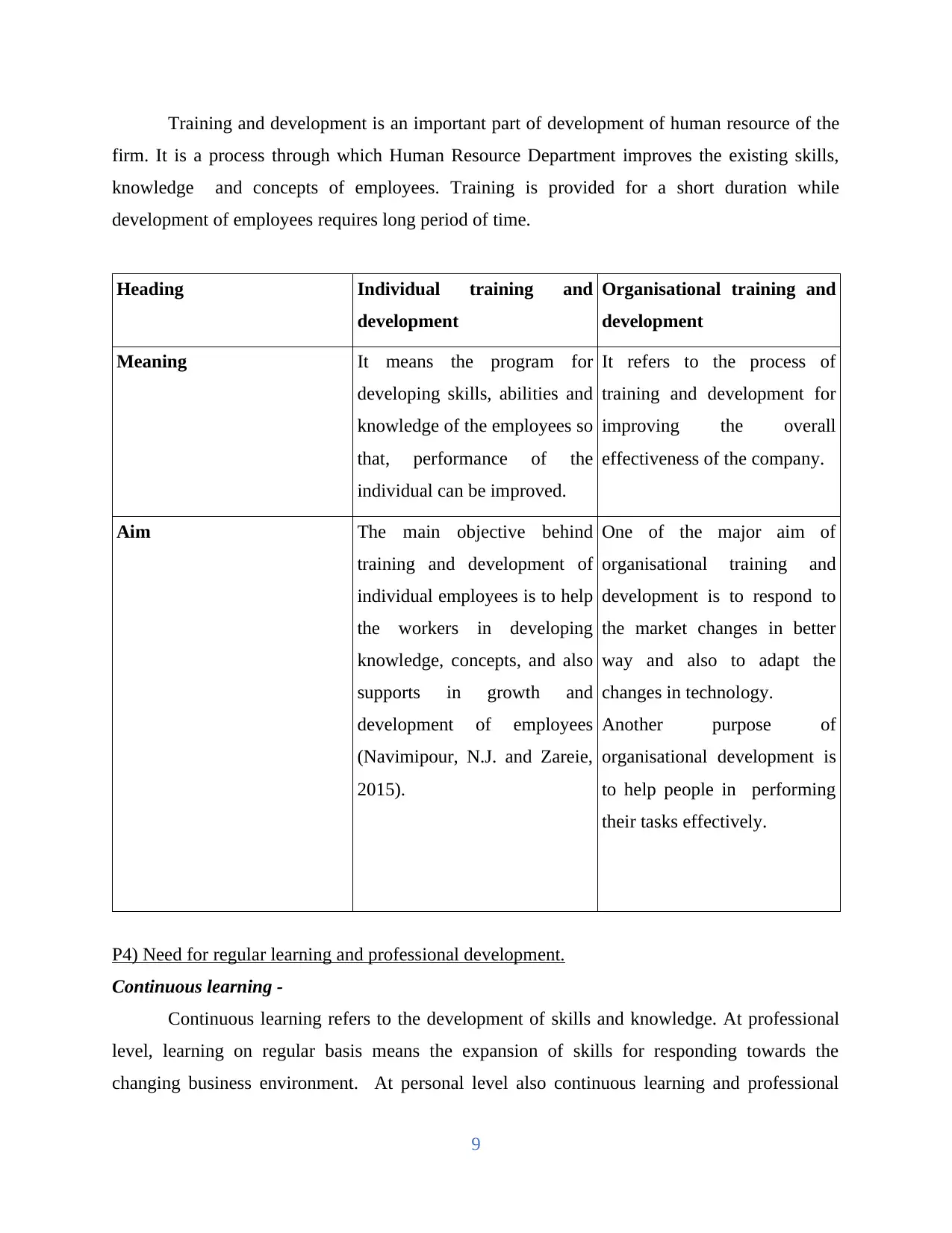
Training and development is an important part of development of human resource of the
firm. It is a process through which Human Resource Department improves the existing skills,
knowledge and concepts of employees. Training is provided for a short duration while
development of employees requires long period of time.
Heading Individual training and
development
Organisational training and
development
Meaning It means the program for
developing skills, abilities and
knowledge of the employees so
that, performance of the
individual can be improved.
It refers to the process of
training and development for
improving the overall
effectiveness of the company.
Aim The main objective behind
training and development of
individual employees is to help
the workers in developing
knowledge, concepts, and also
supports in growth and
development of employees
(Navimipour, N.J. and Zareie,
2015).
One of the major aim of
organisational training and
development is to respond to
the market changes in better
way and also to adapt the
changes in technology.
Another purpose of
organisational development is
to help people in performing
their tasks effectively.
P4) Need for regular learning and professional development.
Continuous learning -
Continuous learning refers to the development of skills and knowledge. At professional
level, learning on regular basis means the expansion of skills for responding towards the
changing business environment. At personal level also continuous learning and professional
9
firm. It is a process through which Human Resource Department improves the existing skills,
knowledge and concepts of employees. Training is provided for a short duration while
development of employees requires long period of time.
Heading Individual training and
development
Organisational training and
development
Meaning It means the program for
developing skills, abilities and
knowledge of the employees so
that, performance of the
individual can be improved.
It refers to the process of
training and development for
improving the overall
effectiveness of the company.
Aim The main objective behind
training and development of
individual employees is to help
the workers in developing
knowledge, concepts, and also
supports in growth and
development of employees
(Navimipour, N.J. and Zareie,
2015).
One of the major aim of
organisational training and
development is to respond to
the market changes in better
way and also to adapt the
changes in technology.
Another purpose of
organisational development is
to help people in performing
their tasks effectively.
P4) Need for regular learning and professional development.
Continuous learning -
Continuous learning refers to the development of skills and knowledge. At professional
level, learning on regular basis means the expansion of skills for responding towards the
changing business environment. At personal level also continuous learning and professional
9
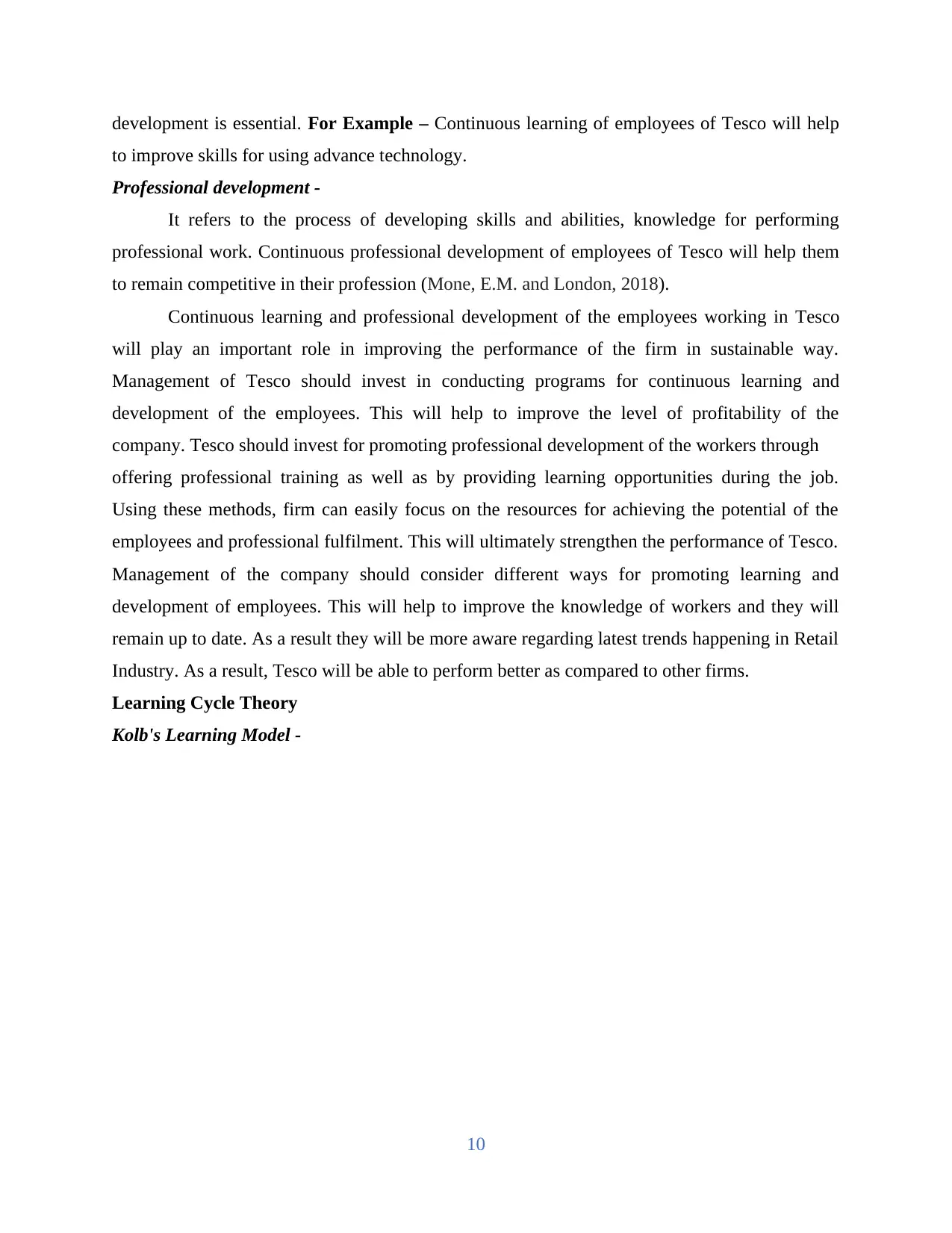
development is essential. For Example – Continuous learning of employees of Tesco will help
to improve skills for using advance technology.
Professional development -
It refers to the process of developing skills and abilities, knowledge for performing
professional work. Continuous professional development of employees of Tesco will help them
to remain competitive in their profession (Mone, E.M. and London, 2018).
Continuous learning and professional development of the employees working in Tesco
will play an important role in improving the performance of the firm in sustainable way.
Management of Tesco should invest in conducting programs for continuous learning and
development of the employees. This will help to improve the level of profitability of the
company. Tesco should invest for promoting professional development of the workers through
offering professional training as well as by providing learning opportunities during the job.
Using these methods, firm can easily focus on the resources for achieving the potential of the
employees and professional fulfilment. This will ultimately strengthen the performance of Tesco.
Management of the company should consider different ways for promoting learning and
development of employees. This will help to improve the knowledge of workers and they will
remain up to date. As a result they will be more aware regarding latest trends happening in Retail
Industry. As a result, Tesco will be able to perform better as compared to other firms.
Learning Cycle Theory
Kolb's Learning Model -
10
to improve skills for using advance technology.
Professional development -
It refers to the process of developing skills and abilities, knowledge for performing
professional work. Continuous professional development of employees of Tesco will help them
to remain competitive in their profession (Mone, E.M. and London, 2018).
Continuous learning and professional development of the employees working in Tesco
will play an important role in improving the performance of the firm in sustainable way.
Management of Tesco should invest in conducting programs for continuous learning and
development of the employees. This will help to improve the level of profitability of the
company. Tesco should invest for promoting professional development of the workers through
offering professional training as well as by providing learning opportunities during the job.
Using these methods, firm can easily focus on the resources for achieving the potential of the
employees and professional fulfilment. This will ultimately strengthen the performance of Tesco.
Management of the company should consider different ways for promoting learning and
development of employees. This will help to improve the knowledge of workers and they will
remain up to date. As a result they will be more aware regarding latest trends happening in Retail
Industry. As a result, Tesco will be able to perform better as compared to other firms.
Learning Cycle Theory
Kolb's Learning Model -
10
Secure Best Marks with AI Grader
Need help grading? Try our AI Grader for instant feedback on your assignments.
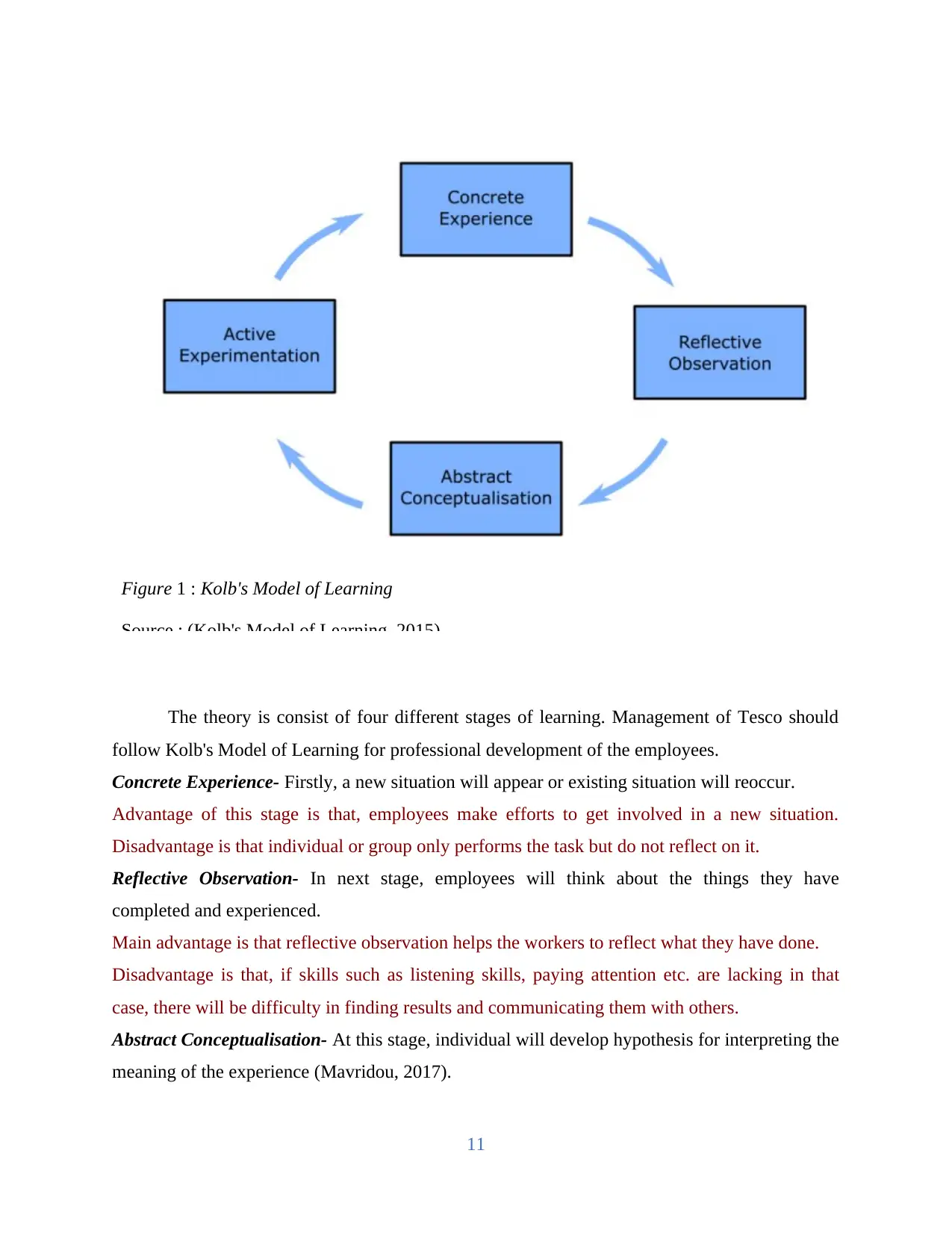
The theory is consist of four different stages of learning. Management of Tesco should
follow Kolb's Model of Learning for professional development of the employees.
Concrete Experience- Firstly, a new situation will appear or existing situation will reoccur.
Advantage of this stage is that, employees make efforts to get involved in a new situation.
Disadvantage is that individual or group only performs the task but do not reflect on it.
Reflective Observation- In next stage, employees will think about the things they have
completed and experienced.
Main advantage is that reflective observation helps the workers to reflect what they have done.
Disadvantage is that, if skills such as listening skills, paying attention etc. are lacking in that
case, there will be difficulty in finding results and communicating them with others.
Abstract Conceptualisation- At this stage, individual will develop hypothesis for interpreting the
meaning of the experience (Mavridou, 2017).
11
Figure 1 : Kolb's Model of Learning
Source : (Kolb's Model of Learning, 2015)
follow Kolb's Model of Learning for professional development of the employees.
Concrete Experience- Firstly, a new situation will appear or existing situation will reoccur.
Advantage of this stage is that, employees make efforts to get involved in a new situation.
Disadvantage is that individual or group only performs the task but do not reflect on it.
Reflective Observation- In next stage, employees will think about the things they have
completed and experienced.
Main advantage is that reflective observation helps the workers to reflect what they have done.
Disadvantage is that, if skills such as listening skills, paying attention etc. are lacking in that
case, there will be difficulty in finding results and communicating them with others.
Abstract Conceptualisation- At this stage, individual will develop hypothesis for interpreting the
meaning of the experience (Mavridou, 2017).
11
Figure 1 : Kolb's Model of Learning
Source : (Kolb's Model of Learning, 2015)
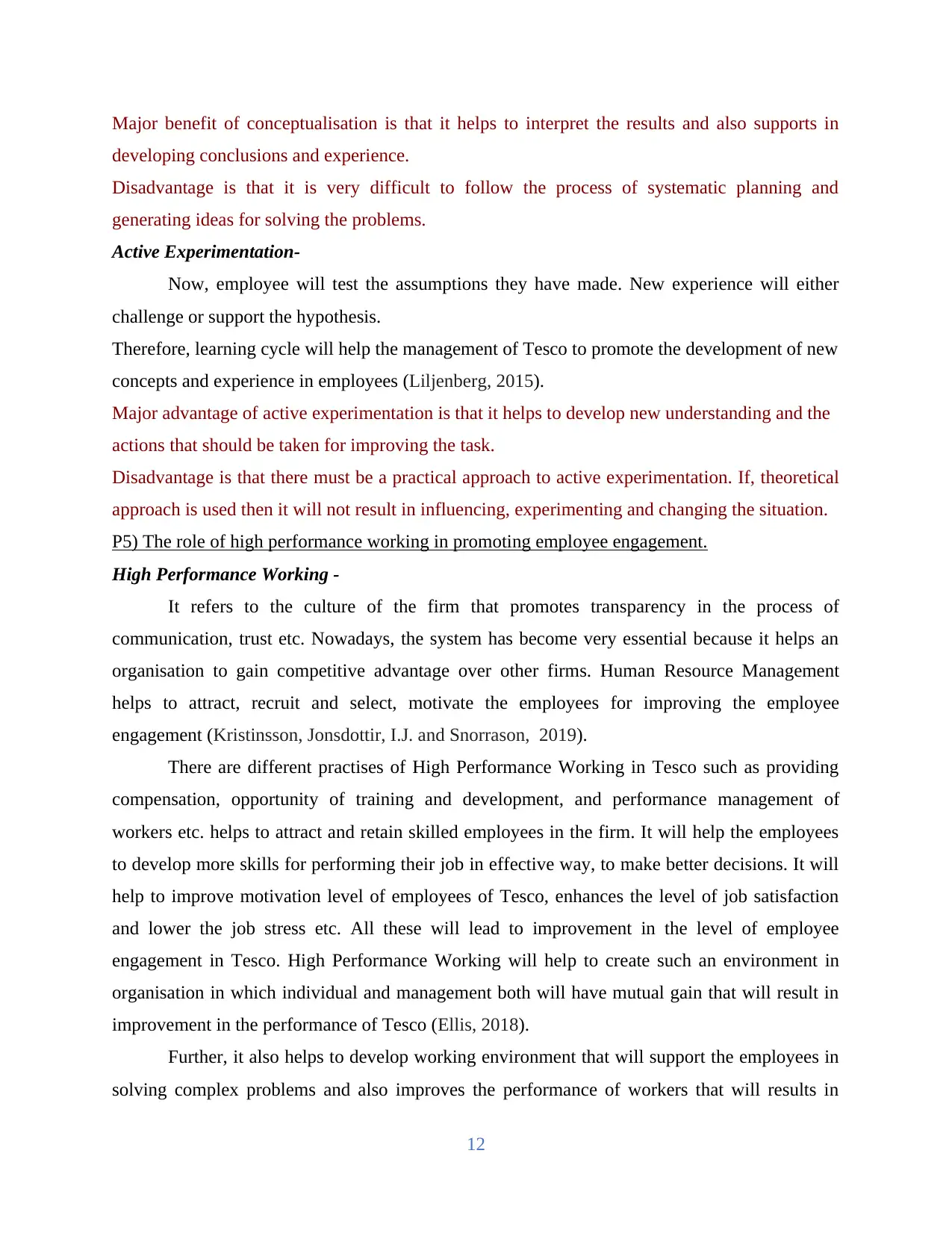
Major benefit of conceptualisation is that it helps to interpret the results and also supports in
developing conclusions and experience.
Disadvantage is that it is very difficult to follow the process of systematic planning and
generating ideas for solving the problems.
Active Experimentation-
Now, employee will test the assumptions they have made. New experience will either
challenge or support the hypothesis.
Therefore, learning cycle will help the management of Tesco to promote the development of new
concepts and experience in employees (Liljenberg, 2015).
Major advantage of active experimentation is that it helps to develop new understanding and the
actions that should be taken for improving the task.
Disadvantage is that there must be a practical approach to active experimentation. If, theoretical
approach is used then it will not result in influencing, experimenting and changing the situation.
P5) The role of high performance working in promoting employee engagement.
High Performance Working -
It refers to the culture of the firm that promotes transparency in the process of
communication, trust etc. Nowadays, the system has become very essential because it helps an
organisation to gain competitive advantage over other firms. Human Resource Management
helps to attract, recruit and select, motivate the employees for improving the employee
engagement (Kristinsson, Jonsdottir, I.J. and Snorrason, 2019).
There are different practises of High Performance Working in Tesco such as providing
compensation, opportunity of training and development, and performance management of
workers etc. helps to attract and retain skilled employees in the firm. It will help the employees
to develop more skills for performing their job in effective way, to make better decisions. It will
help to improve motivation level of employees of Tesco, enhances the level of job satisfaction
and lower the job stress etc. All these will lead to improvement in the level of employee
engagement in Tesco. High Performance Working will help to create such an environment in
organisation in which individual and management both will have mutual gain that will result in
improvement in the performance of Tesco (Ellis, 2018).
Further, it also helps to develop working environment that will support the employees in
solving complex problems and also improves the performance of workers that will results in
12
developing conclusions and experience.
Disadvantage is that it is very difficult to follow the process of systematic planning and
generating ideas for solving the problems.
Active Experimentation-
Now, employee will test the assumptions they have made. New experience will either
challenge or support the hypothesis.
Therefore, learning cycle will help the management of Tesco to promote the development of new
concepts and experience in employees (Liljenberg, 2015).
Major advantage of active experimentation is that it helps to develop new understanding and the
actions that should be taken for improving the task.
Disadvantage is that there must be a practical approach to active experimentation. If, theoretical
approach is used then it will not result in influencing, experimenting and changing the situation.
P5) The role of high performance working in promoting employee engagement.
High Performance Working -
It refers to the culture of the firm that promotes transparency in the process of
communication, trust etc. Nowadays, the system has become very essential because it helps an
organisation to gain competitive advantage over other firms. Human Resource Management
helps to attract, recruit and select, motivate the employees for improving the employee
engagement (Kristinsson, Jonsdottir, I.J. and Snorrason, 2019).
There are different practises of High Performance Working in Tesco such as providing
compensation, opportunity of training and development, and performance management of
workers etc. helps to attract and retain skilled employees in the firm. It will help the employees
to develop more skills for performing their job in effective way, to make better decisions. It will
help to improve motivation level of employees of Tesco, enhances the level of job satisfaction
and lower the job stress etc. All these will lead to improvement in the level of employee
engagement in Tesco. High Performance Working will help to create such an environment in
organisation in which individual and management both will have mutual gain that will result in
improvement in the performance of Tesco (Ellis, 2018).
Further, it also helps to develop working environment that will support the employees in
solving complex problems and also improves the performance of workers that will results in
12
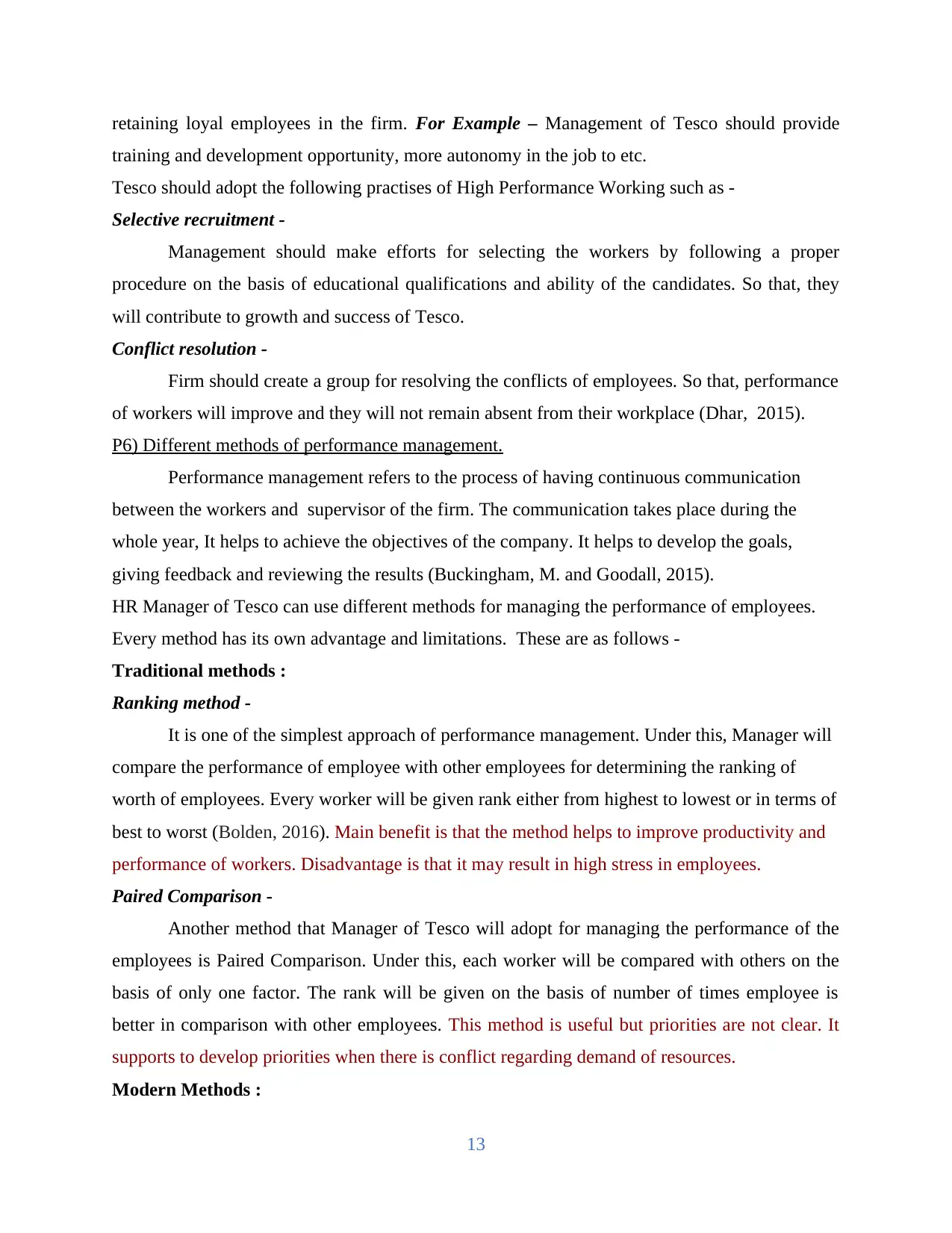
retaining loyal employees in the firm. For Example – Management of Tesco should provide
training and development opportunity, more autonomy in the job to etc.
Tesco should adopt the following practises of High Performance Working such as -
Selective recruitment -
Management should make efforts for selecting the workers by following a proper
procedure on the basis of educational qualifications and ability of the candidates. So that, they
will contribute to growth and success of Tesco.
Conflict resolution -
Firm should create a group for resolving the conflicts of employees. So that, performance
of workers will improve and they will not remain absent from their workplace (Dhar, 2015).
P6) Different methods of performance management.
Performance management refers to the process of having continuous communication
between the workers and supervisor of the firm. The communication takes place during the
whole year, It helps to achieve the objectives of the company. It helps to develop the goals,
giving feedback and reviewing the results (Buckingham, M. and Goodall, 2015).
HR Manager of Tesco can use different methods for managing the performance of employees.
Every method has its own advantage and limitations. These are as follows -
Traditional methods :
Ranking method -
It is one of the simplest approach of performance management. Under this, Manager will
compare the performance of employee with other employees for determining the ranking of
worth of employees. Every worker will be given rank either from highest to lowest or in terms of
best to worst (Bolden, 2016). Main benefit is that the method helps to improve productivity and
performance of workers. Disadvantage is that it may result in high stress in employees.
Paired Comparison -
Another method that Manager of Tesco will adopt for managing the performance of the
employees is Paired Comparison. Under this, each worker will be compared with others on the
basis of only one factor. The rank will be given on the basis of number of times employee is
better in comparison with other employees. This method is useful but priorities are not clear. It
supports to develop priorities when there is conflict regarding demand of resources.
Modern Methods :
13
training and development opportunity, more autonomy in the job to etc.
Tesco should adopt the following practises of High Performance Working such as -
Selective recruitment -
Management should make efforts for selecting the workers by following a proper
procedure on the basis of educational qualifications and ability of the candidates. So that, they
will contribute to growth and success of Tesco.
Conflict resolution -
Firm should create a group for resolving the conflicts of employees. So that, performance
of workers will improve and they will not remain absent from their workplace (Dhar, 2015).
P6) Different methods of performance management.
Performance management refers to the process of having continuous communication
between the workers and supervisor of the firm. The communication takes place during the
whole year, It helps to achieve the objectives of the company. It helps to develop the goals,
giving feedback and reviewing the results (Buckingham, M. and Goodall, 2015).
HR Manager of Tesco can use different methods for managing the performance of employees.
Every method has its own advantage and limitations. These are as follows -
Traditional methods :
Ranking method -
It is one of the simplest approach of performance management. Under this, Manager will
compare the performance of employee with other employees for determining the ranking of
worth of employees. Every worker will be given rank either from highest to lowest or in terms of
best to worst (Bolden, 2016). Main benefit is that the method helps to improve productivity and
performance of workers. Disadvantage is that it may result in high stress in employees.
Paired Comparison -
Another method that Manager of Tesco will adopt for managing the performance of the
employees is Paired Comparison. Under this, each worker will be compared with others on the
basis of only one factor. The rank will be given on the basis of number of times employee is
better in comparison with other employees. This method is useful but priorities are not clear. It
supports to develop priorities when there is conflict regarding demand of resources.
Modern Methods :
13
Paraphrase This Document
Need a fresh take? Get an instant paraphrase of this document with our AI Paraphraser
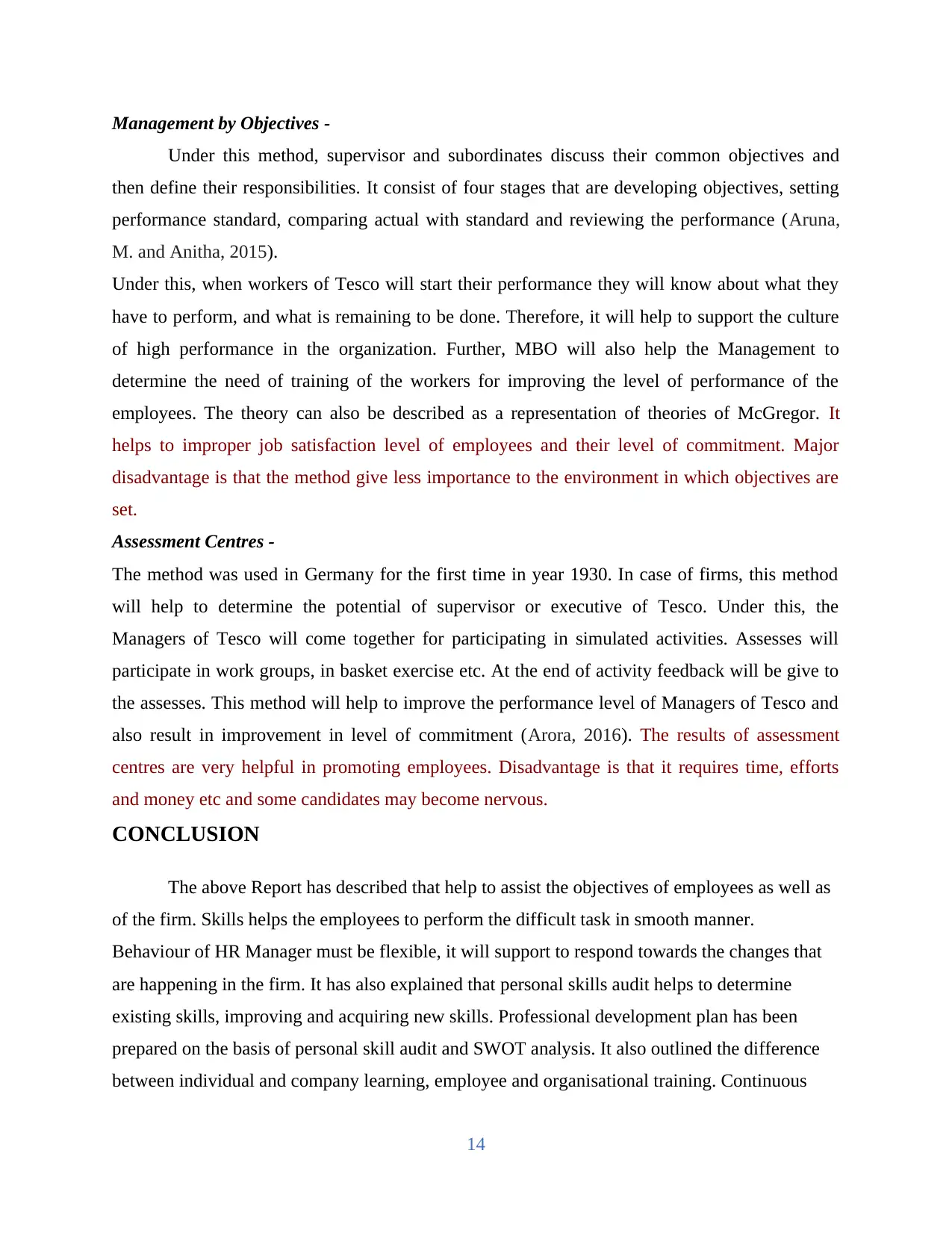
Management by Objectives -
Under this method, supervisor and subordinates discuss their common objectives and
then define their responsibilities. It consist of four stages that are developing objectives, setting
performance standard, comparing actual with standard and reviewing the performance (Aruna,
M. and Anitha, 2015).
Under this, when workers of Tesco will start their performance they will know about what they
have to perform, and what is remaining to be done. Therefore, it will help to support the culture
of high performance in the organization. Further, MBO will also help the Management to
determine the need of training of the workers for improving the level of performance of the
employees. The theory can also be described as a representation of theories of McGregor. It
helps to improper job satisfaction level of employees and their level of commitment. Major
disadvantage is that the method give less importance to the environment in which objectives are
set.
Assessment Centres -
The method was used in Germany for the first time in year 1930. In case of firms, this method
will help to determine the potential of supervisor or executive of Tesco. Under this, the
Managers of Tesco will come together for participating in simulated activities. Assesses will
participate in work groups, in basket exercise etc. At the end of activity feedback will be give to
the assesses. This method will help to improve the performance level of Managers of Tesco and
also result in improvement in level of commitment (Arora, 2016). The results of assessment
centres are very helpful in promoting employees. Disadvantage is that it requires time, efforts
and money etc and some candidates may become nervous.
CONCLUSION
The above Report has described that help to assist the objectives of employees as well as
of the firm. Skills helps the employees to perform the difficult task in smooth manner.
Behaviour of HR Manager must be flexible, it will support to respond towards the changes that
are happening in the firm. It has also explained that personal skills audit helps to determine
existing skills, improving and acquiring new skills. Professional development plan has been
prepared on the basis of personal skill audit and SWOT analysis. It also outlined the difference
between individual and company learning, employee and organisational training. Continuous
14
Under this method, supervisor and subordinates discuss their common objectives and
then define their responsibilities. It consist of four stages that are developing objectives, setting
performance standard, comparing actual with standard and reviewing the performance (Aruna,
M. and Anitha, 2015).
Under this, when workers of Tesco will start their performance they will know about what they
have to perform, and what is remaining to be done. Therefore, it will help to support the culture
of high performance in the organization. Further, MBO will also help the Management to
determine the need of training of the workers for improving the level of performance of the
employees. The theory can also be described as a representation of theories of McGregor. It
helps to improper job satisfaction level of employees and their level of commitment. Major
disadvantage is that the method give less importance to the environment in which objectives are
set.
Assessment Centres -
The method was used in Germany for the first time in year 1930. In case of firms, this method
will help to determine the potential of supervisor or executive of Tesco. Under this, the
Managers of Tesco will come together for participating in simulated activities. Assesses will
participate in work groups, in basket exercise etc. At the end of activity feedback will be give to
the assesses. This method will help to improve the performance level of Managers of Tesco and
also result in improvement in level of commitment (Arora, 2016). The results of assessment
centres are very helpful in promoting employees. Disadvantage is that it requires time, efforts
and money etc and some candidates may become nervous.
CONCLUSION
The above Report has described that help to assist the objectives of employees as well as
of the firm. Skills helps the employees to perform the difficult task in smooth manner.
Behaviour of HR Manager must be flexible, it will support to respond towards the changes that
are happening in the firm. It has also explained that personal skills audit helps to determine
existing skills, improving and acquiring new skills. Professional development plan has been
prepared on the basis of personal skill audit and SWOT analysis. It also outlined the difference
between individual and company learning, employee and organisational training. Continuous
14
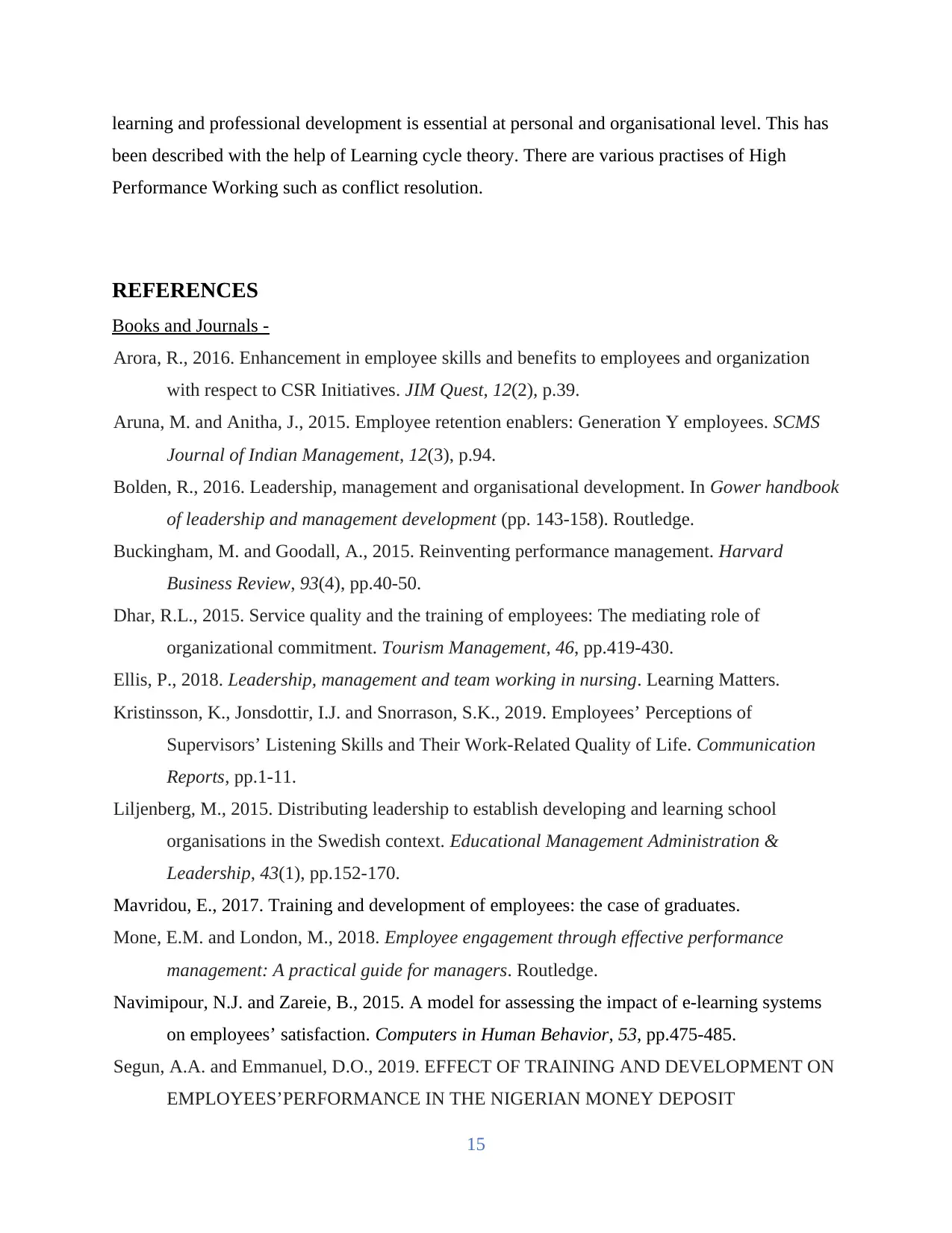
learning and professional development is essential at personal and organisational level. This has
been described with the help of Learning cycle theory. There are various practises of High
Performance Working such as conflict resolution.
REFERENCES
Books and Journals -
Arora, R., 2016. Enhancement in employee skills and benefits to employees and organization
with respect to CSR Initiatives. JIM Quest, 12(2), p.39.
Aruna, M. and Anitha, J., 2015. Employee retention enablers: Generation Y employees. SCMS
Journal of Indian Management, 12(3), p.94.
Bolden, R., 2016. Leadership, management and organisational development. In Gower handbook
of leadership and management development (pp. 143-158). Routledge.
Buckingham, M. and Goodall, A., 2015. Reinventing performance management. Harvard
Business Review, 93(4), pp.40-50.
Dhar, R.L., 2015. Service quality and the training of employees: The mediating role of
organizational commitment. Tourism Management, 46, pp.419-430.
Ellis, P., 2018. Leadership, management and team working in nursing. Learning Matters.
Kristinsson, K., Jonsdottir, I.J. and Snorrason, S.K., 2019. Employees’ Perceptions of
Supervisors’ Listening Skills and Their Work-Related Quality of Life. Communication
Reports, pp.1-11.
Liljenberg, M., 2015. Distributing leadership to establish developing and learning school
organisations in the Swedish context. Educational Management Administration &
Leadership, 43(1), pp.152-170.
Mavridou, E., 2017. Training and development of employees: the case of graduates.
Mone, E.M. and London, M., 2018. Employee engagement through effective performance
management: A practical guide for managers. Routledge.
Navimipour, N.J. and Zareie, B., 2015. A model for assessing the impact of e-learning systems
on employees’ satisfaction. Computers in Human Behavior, 53, pp.475-485.
Segun, A.A. and Emmanuel, D.O., 2019. EFFECT OF TRAINING AND DEVELOPMENT ON
EMPLOYEES’PERFORMANCE IN THE NIGERIAN MONEY DEPOSIT
15
been described with the help of Learning cycle theory. There are various practises of High
Performance Working such as conflict resolution.
REFERENCES
Books and Journals -
Arora, R., 2016. Enhancement in employee skills and benefits to employees and organization
with respect to CSR Initiatives. JIM Quest, 12(2), p.39.
Aruna, M. and Anitha, J., 2015. Employee retention enablers: Generation Y employees. SCMS
Journal of Indian Management, 12(3), p.94.
Bolden, R., 2016. Leadership, management and organisational development. In Gower handbook
of leadership and management development (pp. 143-158). Routledge.
Buckingham, M. and Goodall, A., 2015. Reinventing performance management. Harvard
Business Review, 93(4), pp.40-50.
Dhar, R.L., 2015. Service quality and the training of employees: The mediating role of
organizational commitment. Tourism Management, 46, pp.419-430.
Ellis, P., 2018. Leadership, management and team working in nursing. Learning Matters.
Kristinsson, K., Jonsdottir, I.J. and Snorrason, S.K., 2019. Employees’ Perceptions of
Supervisors’ Listening Skills and Their Work-Related Quality of Life. Communication
Reports, pp.1-11.
Liljenberg, M., 2015. Distributing leadership to establish developing and learning school
organisations in the Swedish context. Educational Management Administration &
Leadership, 43(1), pp.152-170.
Mavridou, E., 2017. Training and development of employees: the case of graduates.
Mone, E.M. and London, M., 2018. Employee engagement through effective performance
management: A practical guide for managers. Routledge.
Navimipour, N.J. and Zareie, B., 2015. A model for assessing the impact of e-learning systems
on employees’ satisfaction. Computers in Human Behavior, 53, pp.475-485.
Segun, A.A. and Emmanuel, D.O., 2019. EFFECT OF TRAINING AND DEVELOPMENT ON
EMPLOYEES’PERFORMANCE IN THE NIGERIAN MONEY DEPOSIT
15
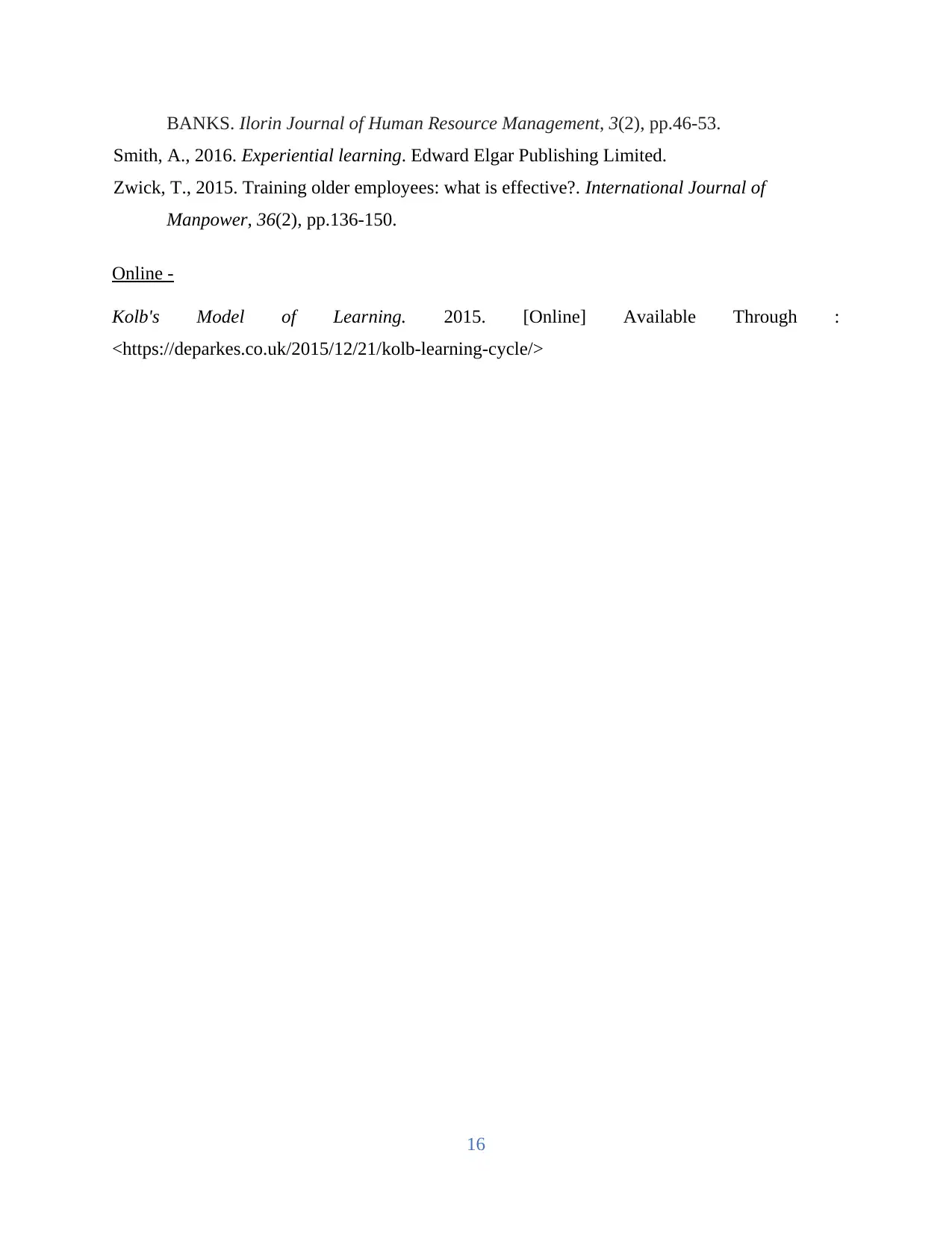
BANKS. Ilorin Journal of Human Resource Management, 3(2), pp.46-53.
Smith, A., 2016. Experiential learning. Edward Elgar Publishing Limited.
Zwick, T., 2015. Training older employees: what is effective?. International Journal of
Manpower, 36(2), pp.136-150.
Online -
Kolb's Model of Learning. 2015. [Online] Available Through :
<https://deparkes.co.uk/2015/12/21/kolb-learning-cycle/>
16
Smith, A., 2016. Experiential learning. Edward Elgar Publishing Limited.
Zwick, T., 2015. Training older employees: what is effective?. International Journal of
Manpower, 36(2), pp.136-150.
Online -
Kolb's Model of Learning. 2015. [Online] Available Through :
<https://deparkes.co.uk/2015/12/21/kolb-learning-cycle/>
16
Secure Best Marks with AI Grader
Need help grading? Try our AI Grader for instant feedback on your assignments.

17

18
1 out of 18
Related Documents
Your All-in-One AI-Powered Toolkit for Academic Success.
+13062052269
info@desklib.com
Available 24*7 on WhatsApp / Email
![[object Object]](/_next/static/media/star-bottom.7253800d.svg)
Unlock your academic potential
© 2024 | Zucol Services PVT LTD | All rights reserved.





